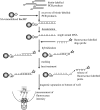Formation of magnetite by bacteria and its application
- PMID: 18559314
- PMCID: PMC2475554
- DOI: 10.1098/rsif.2008.0170
Formation of magnetite by bacteria and its application
Abstract
Magnetic particles offer high technological potential since they can be conveniently collected with an external magnetic field. Magnetotactic bacteria synthesize bacterial magnetic particles (BacMPs) with well-controlled size and morphology. BacMPs are individually covered with thin organic membrane, which confers high and even dispersion in aqueous solutions compared with artificial magnetites, making them ideal biotechnological materials. Recent molecular studies including genome sequence, mutagenesis, gene expression and proteome analyses indicated a number of genes and proteins which play important roles for BacMP biomineralization. Some of the genes and proteins identified from these studies have allowed us to express functional proteins efficiently onto BacMPs, through genetic engineering, permitting the preservation of the protein activity, leading to a simple preparation of functional protein-magnetic particle complexes. They were applicable to high-sensitivity immunoassay, drug screening and cell separation. Furthermore, fully automated single nucleotide polymorphism discrimination and DNA recovery systems have been developed to use these functionalized BacMPs. The nano-sized fine magnetic particles offer vast potential in new nano-techniques.
Figures












Similar articles
-
Molecular analysis of magnetotactic bacteria and development of functional bacterial magnetic particles for nano-biotechnology.Trends Biotechnol. 2007 Apr;25(4):182-8. doi: 10.1016/j.tibtech.2007.02.002. Epub 2007 Feb 15. Trends Biotechnol. 2007. PMID: 17306901 Review.
-
[Protein display onto nano-sized bacterial magnetic particles for receptor analysis].Yakugaku Zasshi. 2009 Nov;129(11):1319-25. doi: 10.1248/yakushi.129.1319. Yakugaku Zasshi. 2009. PMID: 19881203 Review. Japanese.
-
Magnetic genes: Studying the genetics of biomineralization in magnetotactic bacteria.PLoS Genet. 2020 Feb 13;16(2):e1008499. doi: 10.1371/journal.pgen.1008499. eCollection 2020 Feb. PLoS Genet. 2020. PMID: 32053597 Free PMC article. Review.
-
Functional expression of an scFv on bacterial magnetic particles by in vitro docking.Biochem Biophys Res Commun. 2014 Feb 28;445(1):1-5. doi: 10.1016/j.bbrc.2013.12.102. Epub 2014 Jan 25. Biochem Biophys Res Commun. 2014. PMID: 24472552
-
Bioengineering of bacterial magnetic particles and their applications in biotechnology.Recent Pat Biotechnol. 2010 Nov;4(3):214-25. doi: 10.2174/187220810793611455. Recent Pat Biotechnol. 2010. PMID: 21171958 Review.
Cited by
-
Biomanufacturing Biotinylated Magnetic Nanomaterial via Construction and Fermentation of Genetically Engineered Magnetotactic Bacteria.Bioengineering (Basel). 2022 Jul 30;9(8):356. doi: 10.3390/bioengineering9080356. Bioengineering (Basel). 2022. PMID: 36004881 Free PMC article.
-
Identification and localization of proteins associated with biomineralization in the iron deposition vesicles of honeybees (Apis mellifera).PLoS One. 2011 Apr 26;6(4):e19088. doi: 10.1371/journal.pone.0019088. PLoS One. 2011. PMID: 21541330 Free PMC article.
-
Effect of Magnetospirillum gryphiswaldense on serum iron levels in mice.Iran J Microbiol. 2012 Sep;4(3):160-3. Iran J Microbiol. 2012. PMID: 23066493 Free PMC article.
-
Exploring Microbial-Based Green Nanobiotechnology for Wastewater Remediation: A Sustainable Strategy.Nanomaterials (Basel). 2022 Nov 25;12(23):4187. doi: 10.3390/nano12234187. Nanomaterials (Basel). 2022. PMID: 36500810 Free PMC article. Review.
-
In vivo biotinylation of bacterial magnetic particles by a truncated form of Escherichia coli biotin ligase and biotin acceptor peptide.Appl Environ Microbiol. 2010 Sep;76(17):5785-90. doi: 10.1128/AEM.00916-10. Epub 2010 Jul 9. Appl Environ Microbiol. 2010. PMID: 20622127 Free PMC article.
References
-
- Addadi L, Weiner S. Biomineralization—a pavement of pearl. Nature. 1997;389:912. doi: 10.1038/40010. - DOI
-
- Amemiya Y, Arakaki A, Staniland S.S, Tanaka T, Matsunaga T. Controlled formation of magnetite crystal by partial oxidation of ferrous hydroxide in the presence of recombinant magnetotactic bacterial protein Mms6. Biomaterials. 2007;28:5381–5389. doi: 10.1016/j.biomaterials.2007.07.051. - DOI - PubMed
Publication types
MeSH terms
Substances
LinkOut - more resources
Full Text Sources
Other Literature Sources

